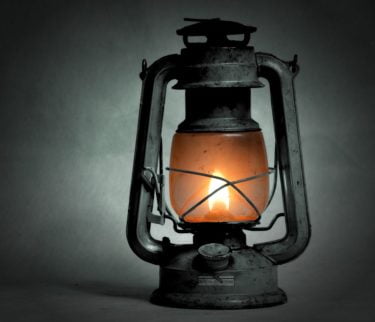It was December 1935, and the explorer Freya Stark was camping in the Hadhramaut, a desolate and dangerous region in the southern Arabian Peninsula. After a long day’s trek across the sands, she and her Bedouin guides were enjoying a pot of coffee around the campfire. But something was stirring in the inky depths of the desert night. ‘We looked in the silence to the darkness and the stars,’ Stark recalled. ‘We were suddenly astonished to see a small light flickering about there.’
The travellers were baffled. None of them recognised the light. Stark suggested that it could be a lantern, ‘bobbing up and down with a donkey.’ However, her guides – who knew the region intimately – were unconvinced. ‘People do not travel by night,’ one of them noted.
Then, as suddenly as it appeared, the light vanished. This seemingly impossible feat settled the matter for her companions. ‘It must be the Gedriya,’ they agreed. Seeing Stark’s blank expression, the guides elaborated: ‘the Gedriya is a great light which sometimes appears in the sky during the 25th night of Ramadan, and it will grant every wish which is made while it is visible.’ The night of Stark’s encounter just so happened to be the 21st December 1935 – in the Islamic calendar, the 25th night of Ramadan.
Coming across this account in Stark’s book, The Southern Gates of Arabia, I was intrigued. If the Bedouin are to be believed, there is – or, at least, was – a mysterious light that would routinely appear over the barren sands of southern Arabia. Adding to the intrigue, the internet had nothing to say on the matter: a search for the name ‘Gedriya’ found nothing. Stark seems to be the only English-speaking writer to have used the term.
So what could the Gedriya have been? Few of the usual suspects for mysterious lights seem to fit the bill. In the 1930s, artificial satellites were still 20 years away, and planes – though not unknown in Arabia – were uncommon, especially at night when conditions were more hazardous. Planets and stars are also unlikely candidates, as the Bedouin relied on the night sky for navigation and would have been very familiar with the position and appearance of these celestial bodies. A meteor or comet is possible, but the movement of the light – described by Stark as ‘bobbing up and down’ – doesn’t seem quite right.
Casting further doubt on a natural explanation is the timing of the Gedriya, which was said to appear every 25th night of Ramadan. The trouble with this is that the Islamic calendar is lunar, unlike the Western solar calendar used around the world today. This means that the 25th night of Ramadan will occur on a different date each year. In 1935 it was the 21st December, but in 2021 it was the 7th May. This makes the mysterious light hard to square with a meteor shower, which align with the solar calendar, or with any known comet, which orbit the sun too slowly to make an appearance every Ramadan.

It’s this intimate connection to a specific date, however, that suggests a possible explanation for legend of the Gedriya. After talking to some friends, I learnt that, in Islamic tradition, the angel Gabriel is said to have descended to Earth with the Koran during the last ten days of Ramadan. The exact date is lost to time, but all Muslims agree that it was an odd-numbered day. Many today believe it to be the 27th night of Ramadan, but a sizeable minority – including, it seems, Stark’s guides – believe it instead to be the 25th night. Whenever it’s celebrated, Qadr Night is one of the most important and widely observed events in the Islamic calendar. And, amid the prayers and solemnities of the night, some Muslims believe Gabriel can still be seen flying across the sky, in a kind of celestial recreation of the angel’s original descent 1,411 years ago.
And so the mystery of the Gedriya probably doesn’t have a physical explanation, as I first wondered, but a cultural one. As the Islamic holy month draws to a close, many Muslims expect to see a light in the sky. ‘Angelic’ lights continue to be witnessed by Muslims today, although the name ‘Gedriya’ seems to have faded into obscurity. There are even videos of supposed angel sightings, although they’re unlikely to convert the faithless. In the same way that a farrago of unrelated phenomena, from planes to planets to party balloons, are all mistakenly identified as UFOs, it seems that anything out of the ordinary is liable to be ascribed to the magic of Qadr Night.
For Stark and her companions, the true nature of their Gedriya encounter quickly became apparent. ‘The light reappeared, nearer,’ she wrote – only now it was accompanied by ‘a sound of feet stumbling over stones.’ As the group peered in the direction of the sound, ‘a voice presently hailed out of the darkness, and three peasants from the wadi, well draped and hooded against the nightly cold, appeared in our circle of firelight.’ They carried a lantern – the very same light that had startled the campers just a short while ago.
Despite the anticlimax, Freya Stark’s experience remains interesting for two reasons. First, it shows how even experts can make simple mistakes. The Bedouin knew the Hadhramaut better than most of us know our own back garden, yet they were unable to identify something as commonplace as a lantern in the disorientating darkness of the Arabian night. Second, it shows how mysterious encounters can have cultural as well as physical causes. Interestingly, Stark – who was unaware of the Gedriya legend – correctly identified the light as a lantern soon after spotting it. When it comes to sceptical enquiry, a little cultural context goes a long way.



